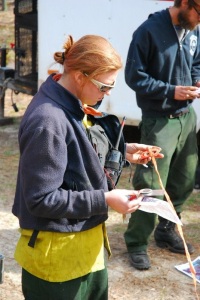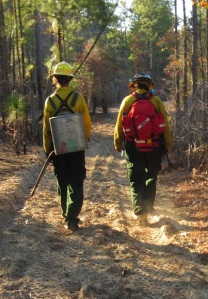 What if we had known then/
What if we had known then/
we could bloom a flame like this?
-Jared Stanley, “Civilian”
Where to begin when remembering, rekindling a world?
I could start with the clothes, the shabbiest of uniforms: briar-shredded fire-splashed Nomex, faded yellow and green; helmets; black leather boots. Goggles, leather gloves, bulging pockets. Team sweatshirts with knowing slogans: “Eco-Burners.” “Tough Enough for Southern Rough.”

I could start with the pain, the illness and injury, the peril of a mislaid flame. I could tell you about my thigh-high scar from too casually throwing a leg over a barbed wire fence; that faded half-moon on my cheek and flash of fire-crisped hair;  that bruise on my coworker’s hip from when I tipped her off the back of an ATV.
that bruise on my coworker’s hip from when I tipped her off the back of an ATV.
I could list for you (how much time have you got?) all the bits and pieces I melted, smashed or simply lost in the woods: bent bars, snapped winches, disappearing bar nuts and oil caps, severed wet-bulb thermometers, and one liquified radio still whimpering from its harness on my chest.

I could tell you about fire: how it feels to light your first drip torch and pull your first stretch of line, watching it bend into the unit toward your neighbor’s flame. How it builds like a rainstorm, thundering across a grassy field. How you stop fearing it and, once or twice, manage to merge its will with your own.

How it feels to paint perfect dots across a hillside then watch them slow-burn toward the crest.

How it feels to over-fire a sensitive ecotone, or scorch a field of infant longleaf pines.

But here is where I choose to begin: with Georgia.
With the land. With the largest state (by land area) east of the Mississippi, a gradation of eco-regions crossed and drained by sloughs and tupeloed rivers, still dressed in swaths by fall-line sandhills and depths of old-growth longleaf pine. Spanish moss, cane and palmetto, pitcher plant bogs, tabby ruins, muddy rivers, feral hogs, gopher tortoise, woodpeckers, racers and rattlers and red clay roads. Turpentined trees with rusted metal troughs. A sunrise to shatter any northerner’s heart.
***

For three winters I vagabonded with a family-crew of prescribed fire technicians under the employ of the Georgia Department of Natural Resources, prepping fire line and restoring flames to fire-adapted, largely fire-suppressed ecosystems. From January through April we lived out of trucks and cabins, and the homes (and kitchens) of the finest hosts I’ve ever known. We showered sparingly, always itched, lived more outdoors than in.

We traveled the entire state, mobilizing wherever and whenever weather allowed for burning on pre-approved, measured, prepped burn sites—in state park land, national forest, Nature Conservancy properties, private tracts and easements.
Anatomy of a Prescribed Fire
Arriving at a burn unit, we would meet local crews and volunteers and rally to fill “drip torches”—spigoted, vented, pourable and portable oil cans—with a fuel mix whose “hotness” depended on its ratio (varying daily) of gasoline and diesel.

Then, we laid out hose, revved portable pumps, and filled engine water tanks from cricks, ponds, or hydrants. Finally we would gather to receive crew and equipment assignments, distribute paper maps, measure weather (temperature, wind speed and direction, and relative humidity), note contingencies, check radios, and learn from the burn bosses about the ecology, history, fire needs, and safety hazards of the unit.

More than once—despite the resource drain of having traveled from all parts of Georgia—the event would be canceled at briefing due to last-minute shifts in wind or weather.
But if it was a go, we would travel in groups to our respective starting areas and light a small test fire—just a few feet of checks and lines, enough to let the bosses determine if wind and fuels might work just so in order to burn the unit “in prescription.”
Then, with approval chiming in on the radio from scattered corners, we would begin.

Often, one crew would light the line—the edge of flammable fuels, bordered by road or cleared soil—while another would “hold,” or defend the line against trickling or blowing flames. After ten or fifteen feet of “black” had been generated at the edge, interior ignition would begin—and here, seasoned firelighters—the most skilled and sensitive land-artists I’ve ever met—would direct and join their crews in painting the forest with dappled fire.
To burn certain fuels requires more closely spaced flames; other vegetation asks for a lighter touch. Some things will simply never burn. We would aim to keep fire from sensitive areas—structures, dead trees (“snags”) near the fire line; young trees; certain heat-fearing shrubs, like a rare rosemary; and “catfaces” (scarred, oily, exposed portions of tree trunks, used in the 19th and early 20th centuries for deriving turpentine for the shipping industry)—by clearing protective circles or trenches around them, and perhaps firing off the edge of those circles, creating even more defensive fuelless “black.”
We worked in concert, through radios and signals and eventually by learning each other’s paces, always watching out for each other’s health and sanity. Wildland fire—even prescribed fire—is a culture prone to pride, and it was always hard to admit one’s need for a break.
A given day’s “burn window”—the hours between which prescribed fire is most effective and fuels most receptive—is guided by relative humidity, a measure determined by taking air temperatures on both wet and dry thermometers, then comparing the numbers on a slide rule.

The lower the “RH,” generally, the flashier the flames; the higher the RH, the wetter the fuels and air and more stubborn the burning. As the daily weather-taker reads hourly measurements over the radio, crews sweat to finish the task and “beat the clock” before the burn window closes.
When leaders deemed a burn completed, crews switched modes, trading flames for shovels, saws, hoses, picks, and fire rakes.

“Mop-up” entails circling the entire burn unit and putting out flames or smokes close enough to the line that they might leak the fire out of bounds after crews have left the area. Initial burn-day mop-up might be “dry”—hand tools and chain saws only—or “wet,” with backpack pumps, ATV and engine-mounted water tanks and hoses. Often, if we were spending the night nearby, we would run an ATV around the line after dark—“midnight mop-up”—and triple-check our work, enchanted by the light show of twinkling snags deep inside the unit. Sometimes we would return the following day and mop-up even further.
I loved mopping up, craved the peace and perspective of the experience.

Most firelighters (and fighters) are thicker-skinned and more adrenaline-fueled than myself. But I am a contemplative soul; despite the draw of the flames, I have been mystified, grateful, hopeful, at great peace standing in the still-smoldering black, watching the remains of the day’s work and wondering how long it will be before young pines spring out of the ashes.

***
So often I have landed in conservation niches involving aggressive, scarring, transformative, inscriptive impact on land and water. I’ve wrestled with my weed-working past at Yellowstone, and wondered more than once about the net gain in scorching (and gasoline-ing, diesel-dumping, and driving trucks across) so much country. My Georgia winters and Yellowstone summers were life highlights, blessed with earthy friendships upon which, often, my life depended. With these gorgeous, dirty people I gypsied cross-country and shot flames from my fingertips—becoming intimate with a landscape no less mysterious or literary than the American South. My knowledge—then, at least—of swamp and sandhill, river bottom and pine forest, was physical, ground-truthed. I miss it.
While writing can be—is—just as restorative, just as transformative as fire, I long for the days, complicated as they were, when my boots wrote the words, coals burned my boots, and Georgia ground her way under my fingernails. I will always crave intimacy, that breathing, flagrant participation with place.







The best writing opens a window on a world we don’t know and probably never will know intimately. This was so fascinating to read! Thank you!
LikeLike
Lovely writing Hilary. Such great memories!
LikeLike
I think the land misses your touch as much as you miss it. You’ve left your mark.
LikeLike
Thanks, all 🙂 Missing the fires and the faces! Be safe out there!
LikeLike